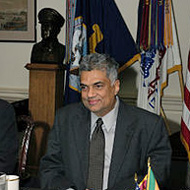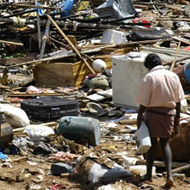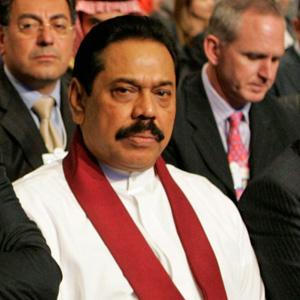SRI LANKA – TIMELINE: 2002-2006
[fivecol_two]
A FRAGILE CEASEFIRE
After the election of Ranil Wickremesinghe as Prime Minister in December 2001, Sri Lankans saw a new possibility for peace.
Norway successfully brokered a ceasefire between the Government of Sri Lanka and the LTTE which became effective in February 2002. Later that year, the Government lifted its ban on the LTTE and in turn the Tamil Tigers dropped their demand for a separate Tamil state, saying they would be willing to accept extensive autonomy in the north and east within a federal system of government.
A Sri Lanka Monitoring Mission (comprised primarily of Nordic countries) was established to monitor the ceasefire and investigate claims of ceasefire violations. There was more good news as the main road linking the Jaffna peninsula in the far north to the rest of the country was reopened after 12 years of being closed.
Initial optimisms fell when the peace negotiations dragged on and the ceasefire agreement was frequently violated by both parties.
In 2004, the Government of Sri Lanka received significant military support from an unexpected source. Karuna, a leading commander of the LTTE, split from the main organisation led by Prabhakaran. To gain power, the Karuna faction collaborated with the Sri Lankan government against the main Prabhakaran-led faction.
[/fivecol_two]
[fivecol_two]
Prime Minister Ranil Wickremesinghe
[/fivecol_two][fivecol_one_last]
[box]
LEARN MORE
CONFLICT TIMELINE
Early Settlement
Colonial Era
Independence (1948)
Conflict Begins (1983)
Fragile Ceasefire (2002-2006)
The War Ends (2006-2009)
Tentative Peace (2009-)
KEY ISSUES
KEY PLAYERS
COOL STUFF
MAPS
.
[button link=”http://pragmora.com/conflicts/search1/” size=”small” bg_color=”#e32609″]Search all conflicts[/button]
[/box]
[/fivecol_one_last][divider_flat]
[fivecol_two]
A window of opportunity for true peace opened in December 2004 when a powerful tsunami struck Sri Lanka (and other Asian countries). In the face of unprecedented devastation to communities and infrastructure, the Government and LTTE agreed to share the more than $4 billion in international aid.
Hopes were short-lived as violence between the two LTTE factions (Karuna’s group backed by the government) intensified in the Eastern Province and the country’s Foreign Minister was assassinated by a Tamil Tiger sniper.
[/fivecol_two]
[fivecol_two]
Tsunami destruction
[/fivecol_two]
[fivecol_one_last]
[/fivecol_one_last][divider_flat]
[fivecol_two]
The course of the civil war shifted in November 2005, when Mahinda Rajapaksa, the sitting Prime Minister, was elected President. Rajapaksa was determined to win a military victory over the Tamil Tigers in the north at all costs.
Violence in the north and the east escalated in late 2005.
(Preliminary research by Logan Dumaine)
CONTINUE: War Rages to an End (2006-May 2009)
[/fivecol_two]
[fivecol_two]
Prime Minister Ranil Wickremesinghe
[/fivecol_two]
[fivecol_one_last]
[/fivecol_one_last]




